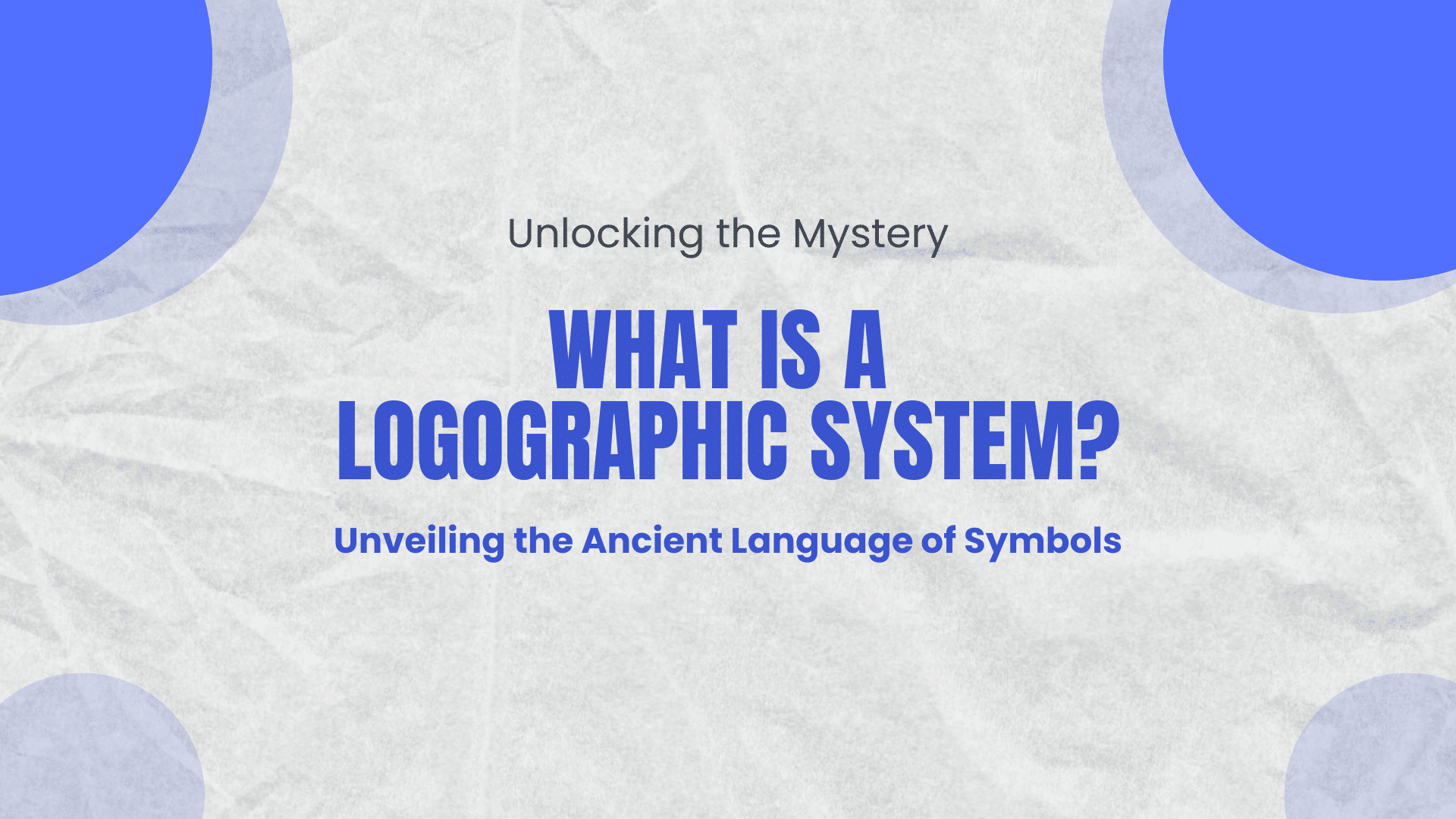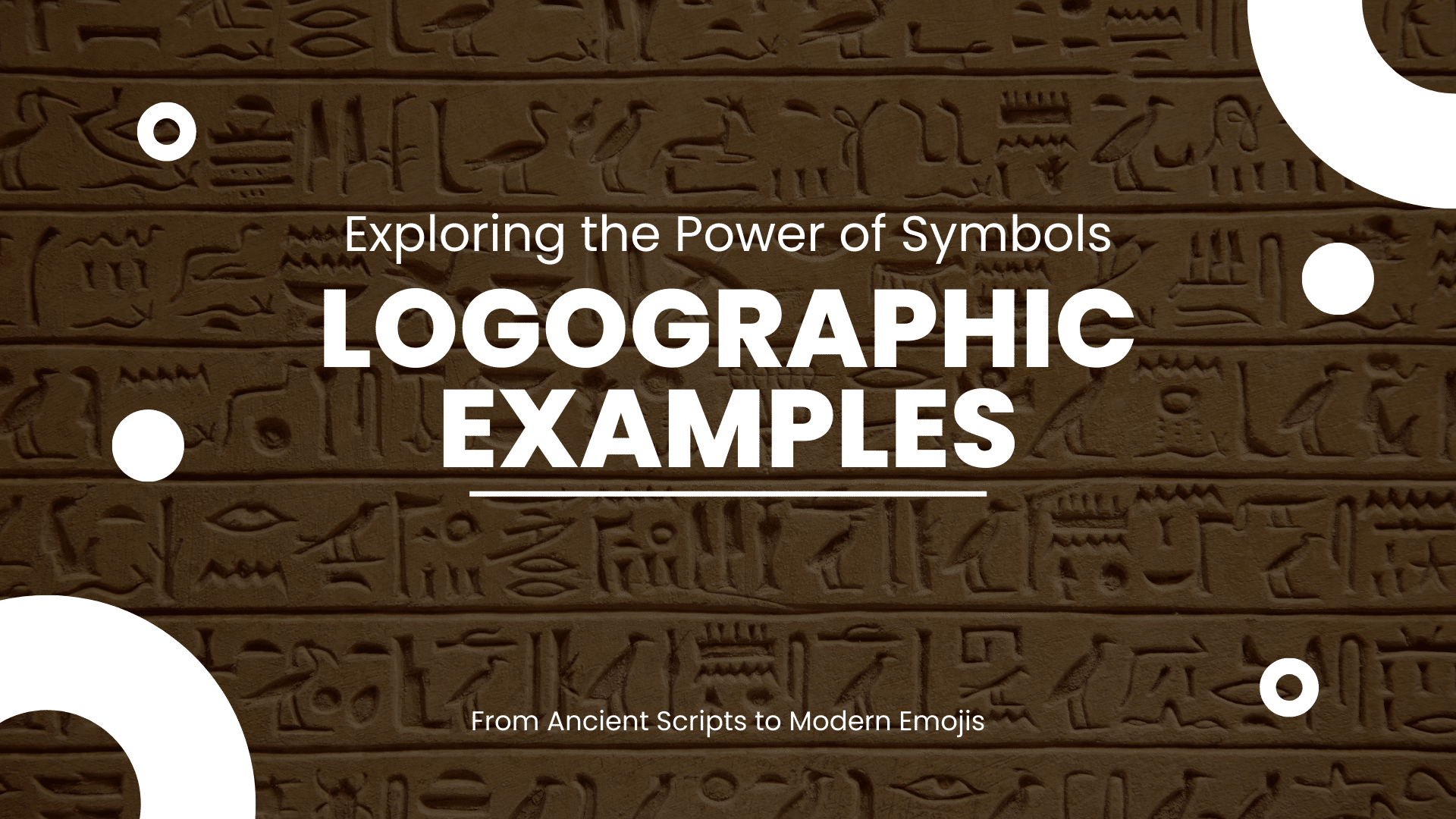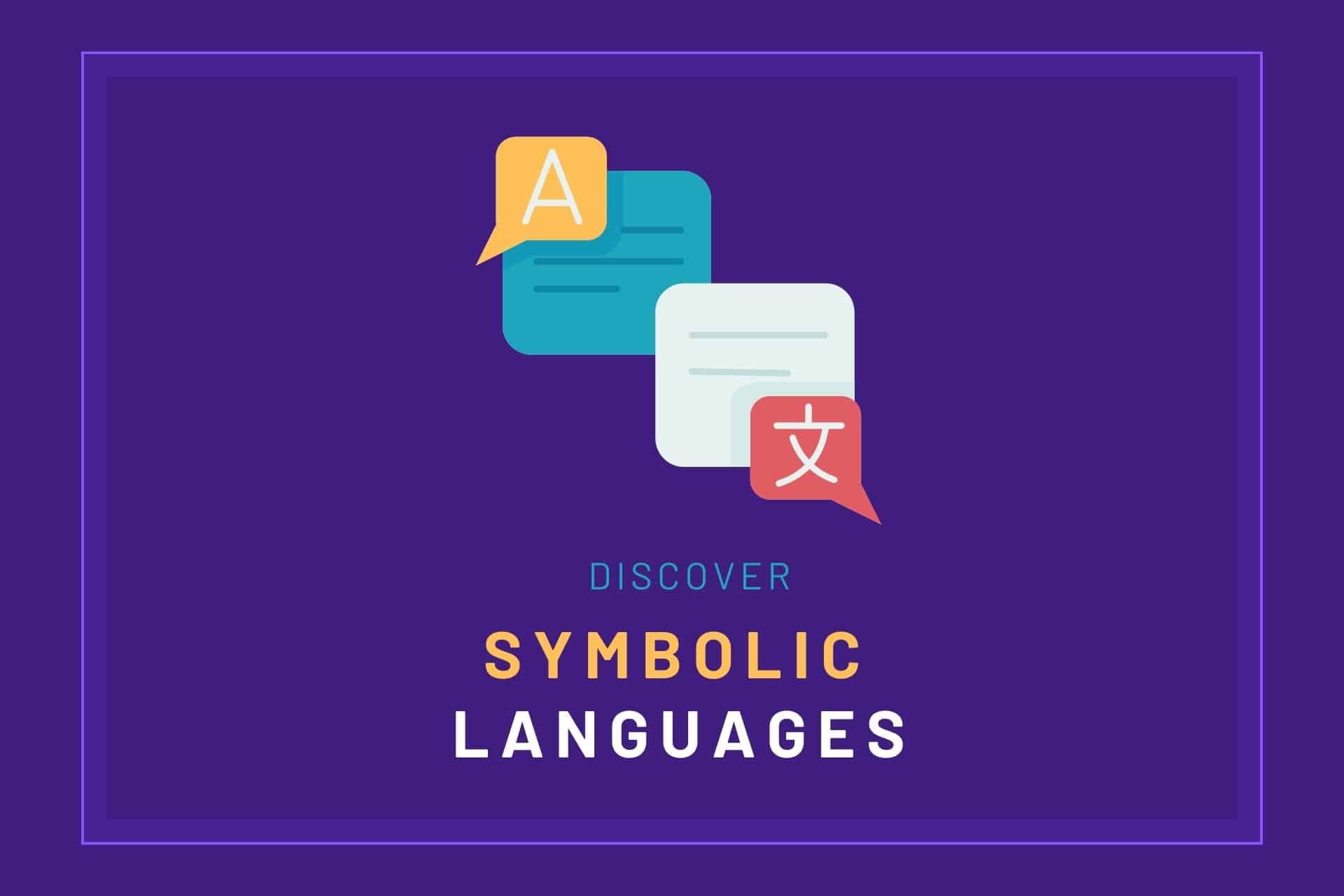If you’ve ever been intrigued by languages like Chinese or Egyptian hieroglyphics, you’ve explored logography. And if you’ve ever tried to decipher traffic signs or pondered the meaning of emojis, you’ve had a brush with ideography.
Are you intrigued?
By the time you finish reading this article, you’ll be equipped to impress at dinner parties and amaze your friends with your newfound knowledge of these intriguing systems.
We promise a journey that will give you a whole new appreciation for the beauty and complexity of human communication.
So, prepare to explore the world of a logograph vs ideograph.
By this end, you might see the world through an entirely new perspective.
Let’s get started!

Here’s What You Will Find
Understanding Logographs
By definition, a logograph is a written character that represents a word or a phrase. The term comes from the Greek words “logos” meaning “word” and “grapho” meaning “to write.” A logograph is like an avatar, a single symbol standing in for a full word.
Logographic systems are primarily used in East Asian languages, most notably Chinese, where each character typically represents a syllable and carries meaning. For example, the Chinese sun character is ‘日’. This character represents the sound of ‘the sun’ and encapsulates the concept of the ‘sun’ itself. Japanese and Korean also use logographs in combination with other writing systems.
What’s fascinating about logographs is how they encapsulate phonetics and semantics. Each one is a world in itself, where form and meaning meet. Imagine writing a whole word with just one symbol. That’s the magic of logography.
Logographs Examples
Logographs, characters representing words or phrases, are found in various languages.
The most commonly known use is in East Asian languages such as Chinese, but you might be surprised to find examples in English too.
- Chinese Logographs: In Chinese, each character typically represents a syllable and carries meaning. For instance, the character ‘人’ represents the concept of a person and is pronounced: “rén.” Similarly, ‘爱,’ which stands for ‘love,’ is pronounced “ài.”
- English Logographs: Now, you might be thinking, “English doesn’t use logographs, does it?” While it’s true that English is primarily an alphabetic system, there are a few notable exceptions. Numerals like ‘1’, ‘2’, ‘3’, etc., are, in fact, logographic. Each numeral represents the word (and the concept) of the number it represents. Other common examples include symbols like ‘@’ for ‘at,’ ‘&’ for ‘and,’ and ‘#’ for ‘number’ or ‘hashtag,’ depending on the context. These symbols represent words, not sounds, which makes them logographs.
- Japanese Logographs: Like the Chinese, the Japanese also utilize logographs, known as Kanji, in combination with other scripts, Hiragana and Katakana. For example, ‘日’ in Japanese, derived from the Chinese logograph, represents the concept of ‘day’ or ‘sun’.
In essence, logographs are present in more places than we often realize. They offer an efficient, space-saving method to convey information and continue to be used in modern digital communication alongside the dominant alphabetic systems.
Understanding Ideographs
On the other side of the spectrum, we have ideographs. An ideograph is a symbol that represents an idea or a concept, independent of any particular language and specific words or phrases. The word “ideograph” originates from the Greek “idea” meaning “idea” and “grapho” meaning “to write.”
Ideographs are visual shorthand for ideas. They distill complex concepts into easily recognizable signs. For example, consider the mathematical sign for addition, ‘+.’ Regardless of your language, this symbol universally represents the concept of addition.
Another prominent example is traffic signs. A red octagon is universally recognized as ‘stop’, no matter what part of the world you are in. The symbol does not correspond to the word ‘stop’ in any specific language but to the concept of stopping itself.
While ideographs seem simple, they’re powerful tools for communication, enabling us to convey ideas quickly and universally, cutting across language barriers.
In essence, while logographs are like narrators telling us the story word by word, ideographs are artists painting the big picture. Each is unique and adds to the rich tapestry of human communication.
Ideograph Examples
Ideographs, symbols that represent ideas or concepts, are frequently seen in our daily lives, often so commonplace that we might not even register them as such. Let’s look at a few examples across various domains:
- Mathematical Symbols: Mathematics has numerous ideographs. The ‘+’ sign is an ideograph for addition, the ‘-‘ sign for subtraction, and the ‘=’ sign for equality. These symbols don’t rely on specific language; their meanings are universal.
- Electronic Symbols: Electronics and technology have given us a new set of ideographs. The ‘⏏’ symbol for ‘eject’ on electronic devices, the power ‘⏻’ symbol, and the ubiquitous ‘WiFi’ 📶 symbol are all ideographs.
- Emojis: In digital communication, emojis are modern-day ideographs representing an idea or concept. A simple smiley face 🙂 represents happiness, a thumbs up 👍 stands for approval, and a heart ♥ signifies love.
- Road Signs: Road signs are classic examples of ideographs used in daily life. The red octagonal sign is universally understood to mean ‘stop’, while a triangular sign with an exclamation mark indicates ‘danger’ or ‘warning.’ They convey vital information quickly and efficiently, regardless of language.
These examples illustrate the power and ubiquity of ideographs in daily communication. Despite their simplicity, they convey a lot of meaning, proving the adage that a picture is indeed worth a thousand words.
Logograph vs Ideograph
Comparing a logograph vs ideograph is like comparing an apple vs orange—each has unique traits that make it distinct. Yet, they both fall under the broader umbrella of symbolic representation.
Similarities Between Logograph vs Ideograph
Exploring the similarities between logographs and ideographs reveals how these visual symbols serve as powerful tools for communication. Both are integral components of written language, offering unique advantages over phonetic scripts by conveying meaning through direct visual representation.
Here are the key similarities outlined with brief descriptions:
Graphical Representations
Both logographs and ideographs are visual symbols used in written communication. They employ images or symbols to represent words, concepts, or phrases.
Direct Conveyance of Meaning
Unlike phonetic scripts, which depend on speech sounds, logographs and ideographs convey meanings more directly. This directness facilitates understanding across different languages and cultures, as interpreting these symbols doesn’t rely on knowing how to pronounce them.
Efficiency in Communication
Due to their ability to represent complex concepts or objects with a single symbol, both logographs and ideographs are highly efficient. This efficiency makes them particularly useful in environments where quick and clear communication is paramount.
Transcendence of Language Barriers
Logographs and ideographs’ visual nature allows them to be understood across linguistic divides. This universality is especially beneficial in multicultural or multilingual settings where a commonly spoken language may not exist.
By focusing on the visual representation of ideas and concepts, logographs and ideographs are crucial in bridging communication gaps, making them invaluable in written language.
Differences Between Logograph vs Ideograph
However, the differences between logograph vs ideograph are where things get interesting.
Representation
The first and perhaps the most fundamental difference lies in what they represent. Logographs represent words or phrases, tying them to specific languages.
Understanding the language is necessary to fully comprehend a logograph’s meaning. On the other hand, ideographs represent ideas or concepts and are not tied to any particular language. Their meaning is universal and can be understood regardless of linguistic background.
Complexity
Logographs, which represent whole words or phrases, can be pretty complex. Each logograph is unique and must be learned individually. Ideographs, by contrast, are typically more straightforward and abstract, aiming for universal recognition.
Flexibility
Ideographs are more flexible than logographs because they aren’t tied to a language’s specific phonetic or grammatical rules. A well-designed ideograph can convey its intended meaning across different languages and cultures, while a logograph’s meaning might be lost to those unfamiliar with the language it’s derived from.
To illustrate these differences, consider the logograph ‘爱’ in Chinese, which represents the word for ‘love’. Unless you know Chinese, you wouldn’t be able to recognize its meaning. Conversely, the heart symbol (♥) used as an ideograph universally represents the idea of ‘love,’ regardless of language or cultural background.
Understanding these differences can provide a new perspective on how we communicate and how written language has evolved and continues to evolve.
So, are you ready to explore some misconceptions and clarifications next?
Misconceptions and Clarifications
The line between logograph vs ideograph can often blur, leading to common misconceptions.
One frequent confusion is the assumption that all East Asian characters are ideographs, representing ideas rather than words. This isn’t accurate. Take Chinese characters, for example. While some represent concrete objects or abstract concepts, many are based on sound and meaning elements that relate to specific words or phrases in the Chinese language, making them logographs.
Another common misconception is that ideographs are purely pictorial, resembling the object or concept they represent. While some ideographs might have started as simple pictures (like a heart representing love), many have evolved into more abstract symbols (like the ‘⏏’ symbol for ‘eject’).
The beauty of studying a logograph vs ideograph is that you’ll appreciate the nuances and complexities of these writing systems, moving beyond oversimplified stereotypes.
FAQs
What is the difference between a symbol and an ideograph?
The difference between a symbol and an ideograph lies primarily in their scope and specificity in conveying meanings within written language:
Symbol: A symbol is a broader term for any mark, sign, object, or graphic representation used to signify an idea, concept, or relationship. Symbols can be found in various contexts, not just language, and include everything from mathematical notations and scientific symbols to religious icons and brand logos. Depending on the context in which they are used, their meanings can be culturally specific, universally understood, or require specialized knowledge.
Ideograph: An ideograph is a specific type of symbol used in written language to represent an idea or concept rather than a specific word or sound. It is part of logographic writing systems, where each character represents a meaning or idea rather than a phonetic component of language. The key characteristic of ideographs is their use in conveying abstract concepts or ideas directly, without referencing the sounds used to pronounce them.
While all ideographs are symbols, not all symbols are ideographs. Ideographs serve a specific function in certain writing systems, denoting ideas or concepts, whereas symbols can have a wider range of applications across different fields and contexts.
What is the difference between an ideograph and a pictograph?
The difference between an ideograph and a pictograph lies in what they represent and how they convey meaning within written language:
Ideograph: An ideograph is a symbol in a writing system representing an idea or concept rather than a specific word, sound, or phrase. It is used to directly convey abstract concepts or complex ideas without relying on the phonetic elements of speech. Ideographs are more about the idea itself than a direct depiction of the object or action.
Pictograph: On the other hand, a pictograph is a symbol representing objects or ideas through a pictorial resemblance to the thing it depicts. Pictographs are essentially simplified drawings that visually resemble what they stand for, making them relatively easy to understand across cultures and languages. They are often considered the earliest forms of writing, where direct visual resemblance was vital in conveying meaning.
In essence, ideographs communicate abstract concepts or ideas without needing to visually resemble those concepts, while pictographs convey meaning through a direct visual representation of the physical object or action they represent.
What is the difference between a logograph and a hieroglyph?
The difference between a logograph and a hieroglyph centers on their specific characteristics and historical contexts within writing systems:
Logograph: A logograph is a written character that represents a word or morpheme (the smallest meaningful unit of language). Logographic characters convey meaning directly rather than phonetically (by sound).
This means each character stands for a concept or word without necessarily indicating how it is pronounced. Logographic writing systems are used in various languages, with Chinese being a prime example. In Chinese, characters represent words or significant parts of words.
Hieroglyph: Hieroglyphs are a specific type of ancient writing system that combines logographic, syllabic, and alphabetic elements. The term is most commonly associated with the ancient Egyptian writing system, though similar scripts were also used in other cultures.
Hieroglyphic writing includes a mix of pictorial symbols (logographs) that can represent objects or ideas and sounds (alphabetic or syllabic characters). Hieroglyphs were used for religious literature on papyrus and wood and in inscriptions on monuments and buildings.
The primary difference lies in their scope and use: while “logograph” refers to the nature of the character in representing language (a character representing a word or idea), “hieroglyph” refers to a specific historical system of writing that includes logographic elements, among others.
Hieroglyphs are thus a subset of logographic writing, with additional layers of complexity and a distinctive aesthetic, deeply intertwined with the cultures that used them. character’s nature in representing language (a character representing a word or idea), “hieroglyph” refers to a specific historical system of writing that includes logographic elements,
What is the difference between a logogram and a Grapheme?
The difference between a logogram and a grapheme lies in their roles and definitions within the structure of written language:
Logogram: A logogram is a single written character representing a whole word or morpheme, the smallest grammatical unit in a language. Logograms convey meaning directly rather than representing individual sounds (phonemes).
Each character stands for a specific word or concept in logographic writing systems, such as Chinese. Logograms can encapsulate complex concepts or entire words within a single character, making them distinct components of written communication.
Grapheme: Each character stands for a specific word or concept in logographic writing systems, such as Chinese. A grapheme is the smallest functional unit in a writing system, representing a phoneme, the slightest sound unit in a language.
Graphemes can be a single letter, like ‘a’ or ‘b,’ or a combination of letters representing a single sound, such as ‘sh’ in English, representing a single phonetic output. Graphemes are the building blocks of alphabetic and syllabic writing systems, serving as the visual representation of sounds.
The key difference is that logograms represent words or concepts directly without indicating their pronunciation. In contrast, graphemes represent sounds and are the fundamental units in the phonetic representation of speech in writing.
Logograms convey meaning in logographic writing systems, whereas graphemes depict the sounds of a language in alphabetic and syllabic systems.
Last Thoughts
There you have it—a journey into the incredible world of logograph vs ideograph!
We’ve explored the essence of these two systems, contrasted their similarities and differences, and debunked some common misconceptions. You’ve now seen the integral roles these symbols play in human communication.
Remember that learning about different writing systems is more than an academic exercise; it’s a window into other cultures and ways of thinking.
So the next time you’re faced with a Chinese character or a traffic sign, take a moment to appreciate the power and beauty of these symbols.
Never stop learning and exploring the intricacies of language, for it is a world where art and science, tradition and innovation, meet and weave magic.
Here’s to the language enthusiast in you; may your curiosity remain ever-vibrant!
Before You Go
And if you’ve found this exploration as fascinating as we hoped, why not share this post with others? Invite friends, family, or fellow language lovers to join in on the discovery.
Sharing spreads knowledge and invites more conversations and insights into the fascinating world of logographs and ideographs. Who knows what new understandings we might uncover together?
Share today and keep the dialogue going!
More on Logographs
Unlocking the Mystery: What Is a Logographic System?
How Logographic Symbols Shape Language and Thought! You might be wondering, “What is a logographic system?” That’s a Good question! Imagine an alphabet, but instead of letters representing sounds, each symbol represents a word or …
Check it Out!Logographic Examples: Unlocking the Secrets of Ancient Civilizations in Your Everyday Texts!
From Ancient Scripts to Modern Emojis Are you curious about the world of logographic examples and what these symbols might signify? This article promises to demystify these symbols, offering a comprehensive exploration of their history, …
Check it Out!Languages with Symbols: Unlock the Mystical Codes of Ancient Civilizations!
Are you fascinated by the mystique of languages with symbols and yearning to unravel their secrets? Often, the biggest challenge lies in deciphering these intricate symbols, each carrying a universe of meaning and history. This …
Check it Out!Logographic Language: Discover How Symbols Can Speak Louder Than Words!
Are you fascinated by the intricate world of logographic language, where symbols convey entire words or phrases? Ever wondered how these captivating scripts, like Chinese or Ancient Egyptian hieroglyphs, differ from the alphabet-based systems we …
Check it Out!More on Symbols

















